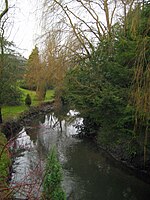Nurton
Hamlets in StaffordshireSouth Staffordshire DistrictStaffordshire geography stubs
Nurton is a hamlet in the South Staffordshire District, in the English county of Staffordshire. Nearby settlements include the city of Wolverhampton and the villages of Perton and Pattingham.
Excerpt from the Wikipedia article Nurton (License: CC BY-SA 3.0, Authors).Nurton
Nurton Bank, South Staffordshire Pattingham and Patshull
Geographical coordinates (GPS) Address Nearby Places Show on map
Geographical coordinates (GPS)
| Latitude | Longitude |
|---|---|
| N 52.5919 ° | E -2.2391 ° |
Address
Nurton Bank
Nurton Bank
WV6 7AB South Staffordshire, Pattingham and Patshull
England, United Kingdom
Open on Google Maps








